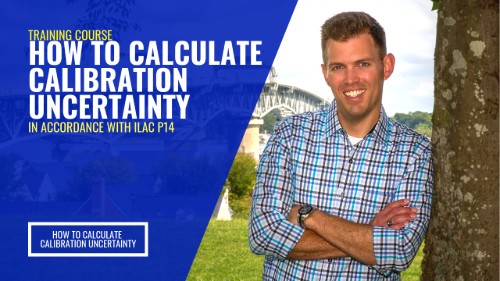Welcome to the most comprehensive course on the calculating and reporting calibration uncertainty.
This course is going to teach you how to calculate and report measurement uncertainty in your calibration reports. The process you will learn is based on the requirements of ISO/IEC 17025:2017 and ILAC P14:01/2013.
If you are an accredited calibration laboratory, this course is for you!
You are going to learn:
- ISO/IEC 17025:2017 Requirements for Reporting Calibration Uncertainty
- ILAC P14:01/2013 Requirements for Reporting Calibration Uncertainty
- How to Calculate Calibration Uncertainty
- How to Report Calibration Uncertainty
- How to Write Uncertainty Statements
- How to Automatically Calculate Uncertainty in your Calibration Templates
Course Curriculum
| Start Here | |||
| Course Introduction: How to Calculate Calibration Uncertainty | 00:12:00 | ||
| Step 1 - The Requirements | |||
| Lesson 1: ISO/IEC 17025:2017 Requirements | 00:09:00 | ||
| Lesson 2: ILAC P14 01/2013 Requirements | 00:17:00 | ||
| Step 2 - The Uncertainty Components | |||
| Lesson 3: How to Calculate CMC Uncertainty | 00:24:00 | ||
| Demo 1: How to Calculate CMC Uncertainty | 00:16:00 | ||
| Lesson 4: How to Find UUT Resolution Uncertainty | 00:34:00 | ||
| Demo 2: How to Find UUT Resolution Uncertainty | 00:11:00 | ||
| Lesson 5: How to Calculate UUT Repeatability | 00:21:00 | ||
| Demo 3: How to Calculate UUT Repeatability | 00:04:00 | ||
| Step 3 - Estimating Uncertainty | |||
| Lesson 6: How to Convert Uncertainty to Standard Deviations | 00:10:00 | ||
| Lesson 7: How to Calculate the Combined Uncertainty | 00:12:00 | ||
| Lesson 8: How to Calculate the Expanded Uncertainty | 00:09:00 | ||
| Demo 4: How to Convert, Combine, and Calculate Expanded Uncertainty | 00:10:00 | ||
| Step 4 - Reporting Uncertainty | |||
| Lesson 9: How to Report Calibration Uncertainty | 00:29:00 | ||
| Lesson 10: How to Evaluate Calibration Uncertainty | 00:12:00 | ||
| Lesson 11: How to Add the Calibration Uncertainty Calculator to Excel Templates | 00:18:00 | ||
| Demo 5: How to Add the Calibration Uncertainty Calculator to Excel Templates | 00:15:00 | ||
Course Reviews
55 STUDENTS ENROLLED





This course covers the essential information that every calibration lab need to know about calibration uncertainties. This class is informative, well presented with multiple examples and great tools everyone in the calibration field can use. I would heartily recommend it.
It was a very useful course for me. Now I understand better the calculation of the uncertainty for our calibration scopes.
The best explination and method of Uncertainty Calculation
I have worked for years performing many Engineering positions around Instrumentation. Recently I have started working more closer with the calibration of the instruments. So I felt the need to learn more about the math and terminology around it. Plus we have received more inquires about being ISO17025 accreditation with our new facility and manufacturing roles. Part of our long term plan is to is to receive ISO17025 accreditation over the next year. So after completing Ricks course “How to Calculate Uncertainty in Accordance with ILAC I’m now much more confident working with Consultants and Meteorologist to help accomplish this. This course is filled with important information, and also points to industry information and groups resources. I have not seen a more informative and well organized training on the subject. Also with the course Rick is accessible to answer questions which is very helpful.
Calibration uncertainty
Excellent contents and delivery. You made complex concepts easy to digest and your calculator was great. Well done!
Review How to Calculate Calibration Uncertainty in Accordance With ILAC P14
This course gave me the ability to learn the baseline needed for ILAC P14. It was easy to follow along and the instructor was phenomenal in giving real time examples that made sense and followed the course objectives.